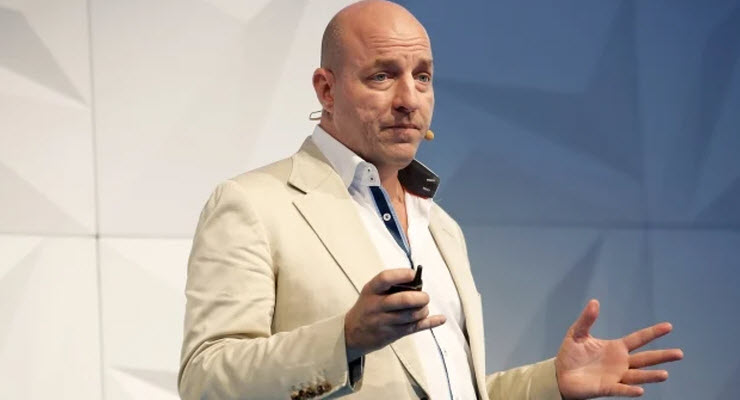
There are a lot of people producing a lot of COVID-19 modelling. And like all forecasting, it will turn out either slightly or very wrong.
In the past few days we had an update to the Doherty Institute modelling based on higher starting infection levels in New South Wales and Victoria, a bizarre effort from a couple of COVID-zero fatalist economists and, most strangely, an all-out attack on the elite Doherty Institute from a controversial entrepreneur.
Throughout the pandemic, the Doherty Institute has been the Goldilocks of Australian experts, treading the difficult path between cautious and optimistic (which is probably why the federal government chose it to assist with its roadmap). Being named after a bloke who won a Nobel prize doesn’t hurt. Nor does being led by the brilliant Professor Sharon Lewin.
Doherty’s modelling seemed very conservative, although understandable — especially given Australia’s addiction to elimination. Its plan B (and C) reopening benchmarks are among the strictest globally. Whereas most Western nations were largely open at 50% vaccination coverage, under the Doherty plan, harsh lockdowns are likely to be used until 64%.
This made the blistering attack on the institute’s modelling by Freelancer.com founder and CEO, controversial entrepreneur Matt Barrie, especially surprising.
Readers with long memories would recall Barrie, who in 2013 rejected a mysterious $434 million offer from Japanese giant Recruit, then listed Freelancer on the ASX and briefly became a unicorn — before its share price collapsed. (Freelancer’s share price has underperformed the ASX by 65% since listing in 2013.)
Meanwhile, Freelancer, which still loses millions of dollars annually, saw its revenue drop in the first half of 2021 and its net loss widen to $1.6 million. The result was surprising given the pandemic as Freelancer’s model is well suited to a dispersed workforce.
Anyway, when Barrie’s not overseeing the perennially loss-making Freelancer, he appears to spend his days criticising expert modelling. His conclusions aren’t surprising; a quick scroll through his Twitter feed indicates he is a COVID-zero ideologue, alongside arts graduate turned health policy adviser Bill Bowtell.
In an aggressive Medium post, Barrie launched a series of attacks on Doherty’s modelling. Disappointingly, the post was widely read after it was retweeted by Biggest Loser celebrity, ABC broadcaster and former doctor Norman Swan.
Barrie claimed Doherty’s modelling was “garbage” because its simulations were cut off after 180 days, alleging that the purpose was to “fudge the data”, and that “COVID is not going to magically disappear in 180 days”.
Doherty partly addressed this in its report, noting that it didn’t properly investigate phases C and D due to “greater uncertainty”, and as Monash University physics Professor Michael Fuhrer noted, the point of the modelling was to understand “in the worst case scenario, how fast does the epidemic get away from us”.
The experts at Doherty were probably smart enough to realise that in six months the vaccination rate will have probably peaked (probably ending up between 75-80% of all people) in any event. Something Barrie — whose epidemiology skills appear comparable with his ability to generate a profit — didn’t seem to grasp.
After 180 days, the COVID caravan was likely to have moved on, a bit like in socially liberal Denmark, which announced this week that all COVID restrictions would end on September 10, stating it would no longer be considered a “socially critical disease”. (Denmark has fully immunised 71% of its population.)
Or perhaps Barrie also disagrees with the eminently cautious Singapore government’s decision to open international travel only two months after reaching 64%.
Barrie then claimed that Doherty’s plan would lead to a shortage of ICU beds. The justification for this was Stephen Duckett (who recently produced his own set of debatable modelling) alleging that “when we hit a trigger point of 12,000 new cases every day, then we know that we will hit ICU capacity shortly after if new cases continue to grow”.
The UK hit 60,000 daily infections (equivalent to 22,000 daily infections in Australia) in January, and barely touched the Nightingale hospitals it created, before quietly closing them all in April. Another interesting data point is the situation in NSW, which has seen slow ICU usage growth, even as cases have rapidly increased.

In his sophomoric rant, Barrie did occasionally land some genuine blows, only to stumble by drawing wrong conclusions. He questioned the Doherty claims that opening up would lead to between 55,000 and 120,000 daily infections (the former at 80% vaccination coverage); 55,000 daily infections is three times as high as the highest ever rate recorded in the US — and that was with no vaccination coverage.
Doherty noted that “the charts are likely to overstate the numbers of infections and deaths”. But remember, Barrie wrote an entire article attacking the modelling for being too optimistic, when Doherty, by its own admission, was likely to be far too conservative.
Interestingly, Barrie didn’t criticise the controversial Grattan Institute report, nor the fatalistic modelling of fellow COVID-zero advocate, agricultural economist Quentin Grafton.
In fact, Barrie used their flawed modelling as evidence that Doherty’s well-regarded modelling was wrong. At one point, Barrie even resorted to the 18-month-old Medium post of fellow tech bro, and Stanford Engineering grad, Tomas Pueyo, as some sort of rebuttal to the assumptions within the detailed months-long work of Australia’s best regarded epidemiologists.
There are of course, no easy decisions. Lifting restrictions inevitably leads to more infections and more deaths, even with high vaccination levels. But maintaining strict interventions results in a cocktail of other calamities, mostly affecting the young and the underprivileged. That is why almost all the world lifted restrictions at far lower vaccination rates, or why some, like Sweden, never imposed strict interventions, but maintained a far lower fatality rate than many regions which did.
Barrie didn’t bother to make any genuine suggestions as to when Australia should start to rejoin the rest of the world. Nor did he seem to consider the effects of continued interventions, like the devastating mental health and domestic violence impacts, or the crippling brunt borne by school students.
Rather, he simply threw up thousands of words of scientifically flawed criticisms from his gilded cage, no doubt encrusted with the gold of long-suffering Freelancer shareholders.
Adam Schwab is a former corporate lawyer, company founder and angel investor. He has written for Crikey and SmartCompany since 2005 and is the author of the best-selling Pigs at the Trough: Lessons from Australia’s Decade of Corporate Greed. He is a board member of Private Media, the publisher of Crikey.








What a selective and self-interested use of data by the owner of a travel business!
No recognition that the NSW health system is already strained under the current caseload. And I’m not buying that professed concern with the “underprivileged”, when we know that there’s a correlation shown around the world – and now in NSW – between disadvantaged communities and COVID-19 cases/hospitalisations/deaths.
Adam Schwab is clearly one of the overprivileged.
Your figure showing the NSW active cases is somewhat misleading. It shows the percentage of all active cases in hospital, ICU and ventilated. The percentage is decreasing, but the total number is increasing. From 28/7 to today, cases in hospital increased from 164 to 840, cases in ICU increased from 56 to 126, and cases on a ventilator increased from 22 to 54 (source: covid19.dat.com.au). It is, of course, the total number of cases in hospital, ICU and ventilated that will determine if the system becomes overwhelmed.
Sorry, the source was misspelt – it is covid19data.com.au
Exactly Tony. It was a tricky little piece of misdirection there. “ Another interesting data point is the situation in NSW, which has seen slow ICU usage growth, even as cases have rapidly increased.”
Wrong analysis, if he is referring to the graph immediately under this statement. This shows ICU and ventilators at small percentages, but as the raw number of cases doubles every fortnight, so then the raw numbers of ICU and ventilated patients. That is, if he had shown the graph in raw numbers it would look like an increasingly steep hill to climb. Add to that a line showing the number of ICU beds, and another for the number of ventilators that could be used with trained nursing supervision and it will quickly go past that, probably before the peak in October (in Gladys’ words).
I just don’t know if it is because Adam doesn’t really understand numbers or if he is being mischievous. If he does understand numbers he is doing exactly what he accuses Matt Barrie of doing, cherry picking.
Further, while he claims the numbers modelled and quoted by Barrie are greater than the US saw in all last year without vaccines, I wonder if he is confusing daily cases with cases, which are obviously different things. Obfuscation, or just misunderstanding?
There is a situation called “Bed Block” which means that any health facility can not fill a bed which is already occupied.
The reason people are dying at home from Covid19 was that they were deemed to be not sick enough for a hospital bed.
On the day total AU Covid deaths top 1,000, the co-founder of Luxury Escapes goes off into statistical fantasy-land.
‘The old saying is that “figures will not lie,” but a new saying is “liars will figure.”’ – a 19th century quote equally applicable to the present day.
FFS, this is journalism??
“Advertorial” journalism.
Another pointless wishy washy opinion piece by Adam Schwab based entirely on misrepresentation, innuendo and assumptions on what people thought and intended rather than of facts.
Disappointing as usual.
Pete
Good to see the author dismisses the opinion of the less than impeccably qualified:
Biggest Loser celebrity, ABC broadcaster and former doctor Norman Swan.
arts graduate turned health policy adviser Bill Bowtell.
We wouldn’t expect non-expert commentary in Crikey, would we?